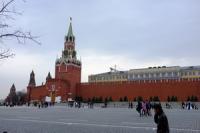-
How secure is your data when it’s stored in the cloud?

Data stored in the cloud is nearly always stored in an encrypted form that would need to be cracked before an intruder could read the information. But as a scholar of cloud computing and cloud security, I’ve seen that where the keys to that encryption are held varies among cloud storage services. In addition, there are relatively simple ways users can boost their own data’s security beyond what’s built into systems they use. Ultimately, for people who don’t want to learn how to program their own tools, there are two basic choices: Find a cloud storage service with trustworthy upload and download software that is open-source and has been validated by independent security researchers. Or use trusted open-source encryption software to encrypt your data before uploading it to the cloud; these are available for all operating systems and are generally free or very low-cost.
-
-
So what did we learn? Looking back on four years of Russia’s cyber-enabled “Active Measures”
Americans continue to investigate, deliberate, and wallow in the aftermath of Russia’s rebirth of “Active Measures” designed to defeat their adversaries through the “force of politics rather than the politics of force.” Kremlin interference in the 2016 U.S. presidential election represents not only the greatest Active Measures success in Russian history, but the swiftest and most pervasive influence effort in world history. Never has a country, in such a short period of time, disrupted the international order through the use of information as quickly and with such sustained effect as Russia has in the last four years. Russia achieved this victory by investing in capabilities where its adversaries have vulnerabilities — cyberspace and social media. Putin’s greatest success through the employment of cyber-enabled Active Measures comes not from winning any single election, but through the winning of sympathetic audiences around the world he can now push, pull, and cajole from within the borders of his adversaries. Much has been learned about Russia’s hackers and troll farms in the year since the 2016 presidential election, but there remain greater insights worth exploring from a strategic perspective when looking at the Kremlin’s pursuit of information warfare holistically.
-
-
What we didn’t learn from Twitter’s news dump on Russiagate
On Friday evening, amid a pending U.S. government shutdown and a presidential porn payoff scandal, Twitter released its long-awaited report on Russian uses of its platform to interfere in the 2016 presidential election. The numbers were striking. Twitter officials said, they had found a cluster of 3,814 accounts that were “a propaganda effort by a Russian government-linked organization known as the Internet Research Agency (IRA).” These were supplemented by a broader project of 50,258 automated accounts — bots — which spread the messaging further. In total, 677,775 people in the United States followed one of these accounts or retweeted or liked a Tweet from these accounts during the election period. Peter Singer writes that social media is about scale and networking, and this combination means that, in actuality, the numbers released by Twitter are far worse than they seem.
-
-
Rubio, Van Hollen introduce legislation to deter foreign interference in American elections
U.S. Senators Marco Rubio (R-Florida) and Chris Van Hollen (D-Maryland) on Tuesday introduced the Defending Elections from Threats by Establishing Redlines (DETER) Act. The senators said it sends a powerful message to any foreign actor seeking to disrupt our elections: if you attack American candidates, campaigns, or voting infrastructure, you will face severe consequences. “We cannot be a country where foreign intelligence agencies attempt to influence our political process without consequences,” said Senator Rubio. “This bill will help to ensure the integrity of our electoral process by using key national security tools to dissuade foreign powers from meddling in our elections.”
-
-
EU issues call to action to combat Russian “propaganda”
The European Commission and lawmakers have accused Russia of orchestrating a “disinformation campaign” aimed at destabilizing the bloc and called for increased measures to combat the threat. “There seems frankly little doubt that the pro-Kremlin disinformation campaign is an orchestrated strategy, delivering the same disinformation stories in as many languages as possible, through as many channels as possible, as often as possible,” EU Security Commissioner Julian King told the European Parliament in Strasbourg on 17 January.
-
-
Declining trust in facts, institutions imposes real costs on U.S. society
Americans’ reliance on facts to discuss public issues has declined significantly in the past two decades, leading to political paralysis and collapse of civil discourse, according to a RAND report. This phenomenon, referred to as “Truth Decay,” is defined by increasing disagreement about facts, a blurring between opinion and fact, an increase in the relative volume of opinion and personal experience over fact, and declining trust in formerly respected sources of factual information.
-
-
Responding to Truth Decay: Q&A with RAND’s Michael Rich and Jennifer Kavanagh
Winston Churchill is reported to have said, “A lie gets halfway around the world before the truth can get its pants on.” Experts say it is worse now. With social media, false or misleading information is disseminated all over the world nearly instantaneously. Another thing that’s new about Truth Decay is the confluence of factors that are interacting in ways we do not fully understand yet. It is not clear that key drivers like our cognitive biases, polarization, changes in the information space, and the education system’s struggle to respond to this sort of challenge have ever coincided at such intensive and extreme levels as they do now. Russian disinformation and hacking campaigns against the United States and other Western democracies are the most obvious examples of the amplification – and exploitation – of Truth Decay. Garry Kasparov, the chess master and Russian dissident, said about Russian disinformation efforts: “The point of modern propaganda isn’t only to misinform or push an agenda. It is to exhaust your critical thinking … to annihilate truth.”
-
-
New malware espionage campaign compromises mobile devices around the world
Cybersecurity experts have uncovered a new malware espionage campaign infecting thousands of people in more than twenty countries. Hundreds of gigabytes of data have been stolen, primarily through mobile devices compromised by fake secure messaging clients. The Trojanized apps, including Signal and WhatsApp, function like the legitimate apps and send and receive messages normally. However, the fake apps also allow the attackers to take photos, retrieve location information, capture audio, and more. The threat, called Dark Caracal, may be a nation-state actor and appears to employ shared infrastructure which has been linked to other nation-state actors.
-
-
Interconnected technological risks: Responding to disruptions of cyber-physical systems
When infectious diseases strike, the World Health Organization acts swiftly, coordinating with the U.S. Centers for Disease Control and Prevention and its foreign counterparts to contain the threat. But there is no equivalent international organization similarly dedicated to identifying and mitigating a cyberattack. The World Economic Forum (WEF), however, is bringing together infrastructure and technology developers, insurers and government officials from across the globe to develop strategies for responding to interconnected technological risks, including those that can cascade when hackers disrupt cyber-physical systems.
-
-
Tracking and reacting to Russian attacks on democracy
Last week, a U.S. government report outlined attacks made by Russian President Vladimir Putin on democratic institutions over nearly two decades. The report details the many ways in which the Russian government has combined Soviet-era approaches with today’s technological tools. Princeton’s Jacob Shapiro says: “While not a revelation to people who have been following the issue, the depth and intensity of Russian efforts against America’s allies in Europe are striking and well-documented in the report. While some may argue that turnabout is fair play insofar as the United States and its European allies have been aggressively pushing their vision of governance inside Russia and its allies for decades, those efforts have taken place in the context of institutions that abide by widely accepted legal norms. What is striking about the Russian effort is the extent to which it employed actors and approaches that clearly and routinely transgress Russian, international, and domestic laws in the places they operate. To me, the extralegal nature of Russian influence efforts was just striking.”
-
-
Threat identification tool addresses cybersecurity in self-driving cars
Instead of taking you home from work, your self-driving car delivers you to a desolate road, where it pulls off on the shoulder and stops. You call your vehicle to pick you up from a store and instead you get a text message: Send $100 worth of Bitcoin to this account and it’ll be right over. You buckle your seatbelt and set your destination to a doctor’s appointment, but your car won’t leave your driveway because it senses it’s been hacked. These three hypothetical scenarios illustrate the breadth of the cybersecurity challenges that must be overcome before autonomous and connected vehicles can be widely adopted. While every new generation of auto tech brings new security risks, the vulnerabilities that come along with advanced mobility are both unprecedented and under-studied, the paper states.
-
-
Time for election reform
Congressional investigations have uncovered extensive interference - attempted fraud - by Russia and other foreign agents, including attempts to hack electronic voting machines, attempts to hack voter rolls to add or delete voters, targeted internet advertising, and targeted fake news and trolling. Here are five obvious reforms to strengthen the “critical infrastructure” of our democracy.
-
-
How to respond to Russia's attacks on democracy

Much of the public discourse concerning Russian interference has highlighted Russia’s use of disinformation to meddle in the U.S. elections, but the Kremlin’s activities extend beyond just interfering in elections. These activities encompass a comprehensive, asymmetric toolkit that exacerbates existing social divisions in Western societies, aiming to undermine democratic governments and institutions. Moscow, as a declining power, has opted for low-cost methods such as information warfare, hacking, political support for extremist groups, economic coercion, and illicit finance in an effort to undermine its perceived enemies in the West and create the perception that democracy is an inherently corrupt system.
-
-
Russia’s troll factory expands office to 12,000 square meters
Russian government disinformation and hacking specialists had good eighteen months: they were successful in their campaigns to bolster far-right, nationalist, anti-European political parties and leaders in France (Marine Le Pen), Germany (AfD), and the Netherlands (Geert Wilders); they were successful in raising the profile of populist causes which would weaken European institutions (Brexit, Catalonian independence, Scottish separatism, and Italy’s referendum); and they succeeded in helping Donald Trump, a polarizing, divisive leader who is more responsive to Russian interests and outlook, become president of the United States. Russia’s infamous troll factory in St. Petersburg, which played a major role in the Russian government’s disinformation campaigns on social media, is expanding its office to 12,000 square meters, three times bigger than its previous work space.
-
-
Intel AMT security issue: Attackers may bypass login credentials in corporate laptops

Helsinki, Finland-based F-Secure reported a security issue affecting most corporate laptops that allows an attacker with physical access to backdoor a device in less than thirty seconds. The issue allows the attacker to bypass the need to enter credentials, including BIOS and Bitlocker passwords and TPM pins, and to gain remote access for later exploitation. It exists within Intel’s Active Management Technology (AMT) and potentially affects millions of laptops globally.
-
More headlines
The long view
States Rush to Combat AI Threat to Elections
This year’s presidential election will be the first since generative AI became widely available. That’s raising fears that millions of voters could be deceived by a barrage of political deepfakes. Congress has done little to address the issue, but states are moving aggressively to respond — though questions remain about how effective any new measures to combat AI-created disinformation will be.
Ransomware Attacks: Death Threats, Endangered Patients and Millions of Dollars in Damages
A ransomware attack on Change Healthcare, a company that processes 15 billion health care transactions annually and deals with 1 in 3 patient records in the United States, is continuing to cause massive disruptions nearly three weeks later. The incident, which started on February 21, has been called the “most significant cyberattack on the U.S. health care system” by the American Hospital Association. It is just the latest example of an increasing trend.
Chinese Government Hackers Targeted Critics of China, U.S. Businesses and Politicians
An indictment was unsealed Monday charging seven nationals of the People’s Republic of China (PRC) with conspiracy to commit computer intrusions and conspiracy to commit wire fraud for their involvement in a PRC-based hacking group that spent approximately 14 years targeting U.S. and foreign critics, businesses, and political officials in furtherance of the PRC’s economic espionage and foreign intelligence objectives.
Autonomous Vehicle Technology Vulnerable to Road Object Spoofing and Vanishing Attacks
Researchers have demonstrated the potentially hazardous vulnerabilities associated with the technology called LiDAR, or Light Detection and Ranging, many autonomous vehicles use to navigate streets, roads and highways. The researchers have shown how to use lasers to fool LiDAR into “seeing” objects that are not present and missing those that are – deficiencies that can cause unwarranted and unsafe braking or collisions.
Tantalizing Method to Study Cyberdeterrence
Tantalus is unlike most war games because it is experimental instead of experiential — the immersive game differs by overlapping scientific rigor and quantitative assessment methods with the experimental sciences, and experimental war gaming provides insightful data for real-world cyberattacks.
